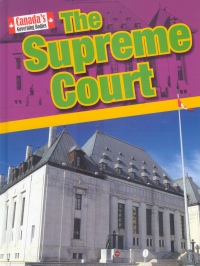| ________________
CM . . .
. Volume XXI Number 31. . . .April 17, 2015

 |
The Supreme Court. (Canada’s Governing Bodies).
Simon Rose.
Calgary, AB: Weigl Educational Publishers, 2015.
32 pp., pbk., hc. & ebook, $13.95 (pbk.), $24.95 (RLB), $35.95 (ebook).
ISBN 978-1-4872-0007-7 (pbk.), ISBN 978-1-4872-0006-0 (RLB), ISBN 978-1-4872-0008-4 (ebook).
Subject Heading:
Canada. Supreme Court-Juvenile literature.
Grades 5-8 / Ages 10-14.
Review by Ian Stewart.
***½ /4
|
| |
|

excerpt:
In Canada the role of the court system is to solve legal disagreements. Judges have to understand and apply the law to the situations that come before them. Almost all court cases begin at the lowest level, in provincial courts. Some of them may be appealed to higher courts.
The Canadian legal system is shaped like a pyramid. The Supreme Court is at the top. It is the county’s highest legal authority. At the base are the provincial and territorial courts. There are several other levels of the legal system in between, each with its own areas of responsibility. As the leading court in the country the Supreme Court’s rulings apply to all other Canadian courts. These decisions may be about criminal law, family law, or law relating to the Constitution of Canada.
This excellent volume in the “Canada’s Governing Bodies” series provides students and teachers with a succinct readable explanation of Canada’s federal government system’s history and operation. In the series, students will learn that Canada’s federal government is a representative parliamentary democracy, largely based on the British model. There are two legislative houses in the federal system: the House of Commons (the lower house) and the Senate (the upper house). There is also the mostly symbolic monarch, represented by the Governor General, and a judiciary composed of the Supreme Court of Canada and the lower federal courts. This volume focuses on the role of the Supreme Court.
The Supreme Court, readers begin to understand, faces complex challenging issues in modern Canadian society regarding freedom of speech, equal rights and civil liberties. Students will learn some of the history of the Supreme Court and some of its most influential justices: William Richards, the first Chief Justice; Bora Laskin, a constitutional expert supporter of Canadian civil liberties; Bertha Wilson, the first female justice, and Beverly McLachlin, the first female Chief Justice. The composition and role of the Supreme Court have evolved over time to meet the needs and legal structures of Canada. At one time, until 1949, rulings of the Supreme Court could be appealed to the British Privy Council and after the Canadian Charter of Rights and Freedoms was introduced, in 1982, the court became the leading legal authority.
The nine justices of the Supreme Court are appointed by the Governor General on the advice of the Prime Minister. They represent the regions of Canada as three must come from Quebec, three from Ontario, two from Western Canada and one from Atlantic Canada. The senior justice is known as the chief justice and the eight junior are known as puisne justices.
The Supreme Court rules on constitutional matters, as it has done recently regarding the House of Commons right to change the structure of the Senate and Canadians right to assisted suicide based on the Charter of Rights and Freedoms. The Supreme Court also hears appeals on the decisions made by lower courts in criminal and civil matters. Students learn that there are three main levels in the Canadian courts system: the Supreme Court, the Superior Courts, which deal with serious criminal cases and review decisions made by lower courts; Provincial and Territorial Courts that deal with lesser crimes, offences against provincial and territorial laws and juvenile cases.
All-in-all, students will find the book a value tool to learn about the function of the Supreme Court. The volume also contains a “Know Your Supreme Court” quiz, a list of supplementary resources, questions to debate, a list of key words and a glossary.
Highly Recommended.
Ian Stewart teaches at Cecil Rhodes School in Winnipeg, MB.

To comment
on this title or this review, send mail to cm@umanitoba.ca.
Copyright © the Manitoba Library Association. Reproduction for personal
use is permitted only if this copyright notice is maintained. Any
other reproduction is prohibited without permission.
Next Review | Table of Contents For This Issue - April 17, 2015
CM Home | Back Issues
| Search
| CM Archive
| Profiles Archive
|
